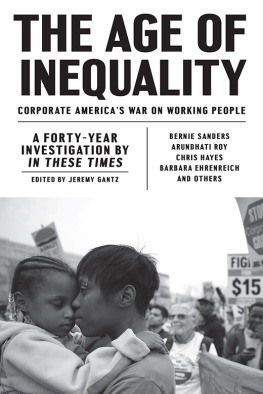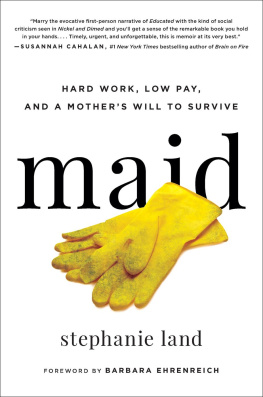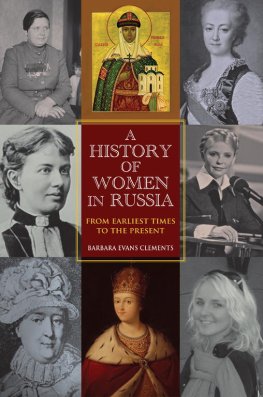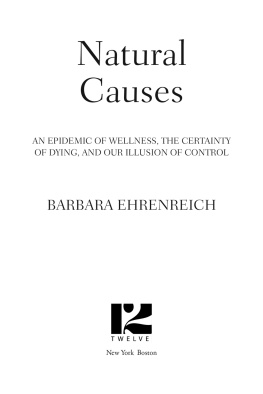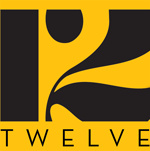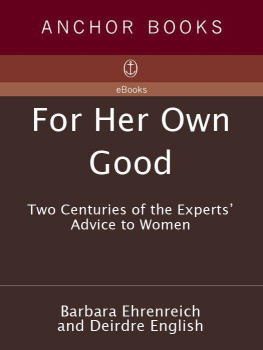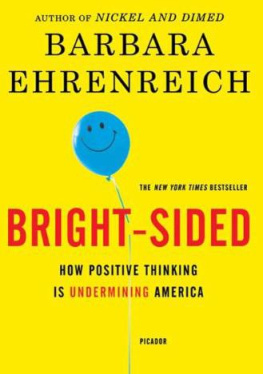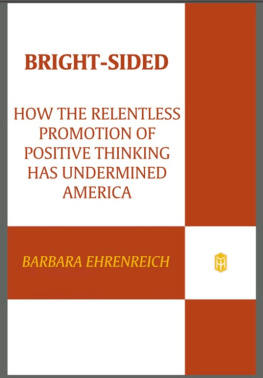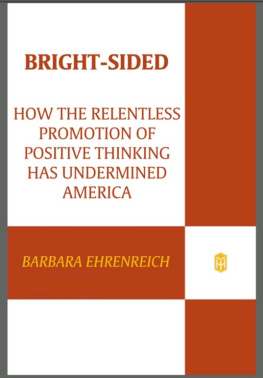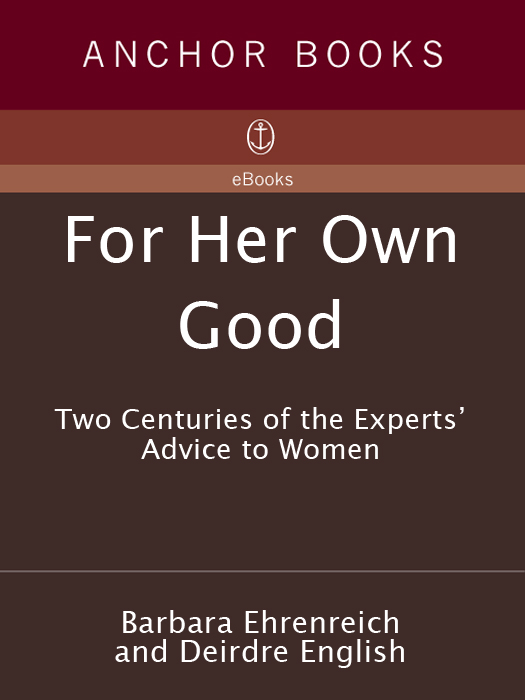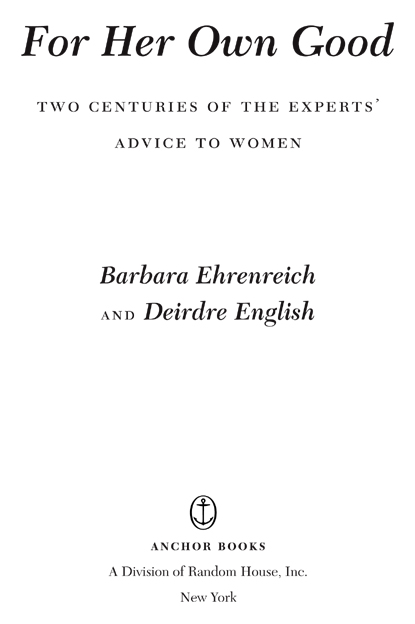Barbara Ehrenreich AND Deirdre English
For Her Own Good
Barbara Ehrenreich has written and lectured widely on subjects related to health care and womens issues. She has contributed articles to Time, Harpers, and The New York Times Book Review, among others. She is the author of Re-making Love: The Feminization of Sex (with Elizabeth Hess and Gloria Jacobs); Blood Rites: Origins and History of the Passions of War; Fear of Falling: The Inner Life of the Middle Class; The Hearts of Men: American Dreams and the Flight from Commitment; Nickel and Dimed: On (Not) Getting By in America and Global Woman: Nannies, Maids and Sex Workers in the New Economy (co-edited with Arlie Russell Hochschild).
Deirdre English has written, taught, and edited work on a wide array of subjects related to investigative reporting, cultural politics, and public policy. She has contributed to Mother Jones, The Nation, and The New York Times Book Review, among other publications, and to public radio and television. A former editor in chief of Mother Jones magazine, she taught at the College at Old Westbury at the State University of New York, the City College of New York, and the University of California at Santa Cruz. She currently directs the Editing Workshops program at the Graduate School of Journalism at the University of California at Berkeley.
ALSO BY Barbara Ehrenreich
AND Deirdre English
Witches, Midwives and Nurses: A History of Women Healers Complaints and Disorders: The Sexual Politics of Sickness
ALSO BY Barbara Ehrenreich
Re-making Love: The Feminization of Sex
(with Elizabeth Hess and Gloria Jacobs)
Blood Rites: Origins and History of the Passions of War
Fear of Falling: The Inner Life of the Middle Class
The Hearts of Men: American Dreams and the Flight from Commitment
Global Woman: Nannies, Maids and Sex Workers in the New Economy
(co-edited with Arlie Russell Hochschild)
Nickel and Dimed: On (Not) Getting By in America
SECOND ANCHOR BOOKS EDITION, J ANUARY 2005
Copyright 1978, 2005 by Barbara Ehrenreich and Deirdre English
All rights reserved under International and Pan-American Copyright Conventions. Published in the United States by Anchor Books, a division of Random House, Inc., New York, and simultaneously in Canada by Random House of Canada Limited, Toronto. Originally published in hardcover in the United States by Anchor Books/Doubleday in 1978.
Anchor Books and colophon are registered trademarks of Random House, Inc.
The Cataloging-in-Publication Data is on file at the Library of Congress.
eISBN: 978-0-307-76416-4
www.anchorbooks.com
v3.1
To our mothers,
Fanita English and Isabelle Isley
CONTENTS
FOREWORD
A sked for or not, advice is all around uson the best-seller lists, in the self-help sections in bookstores, crowding history and literature to the back, in magazines and those sections of the local paper that used to be called womens but now are called lifestyle or leisure. Our not-so-distant ancestors were likely to depend on neighbors and relatives to get them through the hazards of courtship, marriage, childrearing, and various turning points in the life cycle; we are more likely to turn to a physician, psychologist, therapist, or, most recently, a life coach. Even though we know that reading another diet book will not make us thin, that understanding child development will not substitute for time spent with our children, and that the hectoring pop psychologist on TV cannot save our marriages, we are gluttons for disposable information, especially when it comes labeled as the best that the experts have to offer.
In many ways, our reliance on experts makes sense. As well-educated and experienced people, they seem a source of advice far superior to anything a grandmother or aunt might offer: they present themselves as objective and unbiased, basing their instructions, implicitly or explicitly, on scientific studies. If they sometimes turn out to be wrong, it is only because the science underlying their advice evolves from month to month and year to year, and new studies topple old ones. They have no axes to grind, no agendas to advanceor so we are encouraged to believe.
But this trust has again and again been betrayed. Consider the medical profession, which is the paradigmatic advice-giving guild in our society, and the one on which other, often dodgier, advice-giving professions often model themselves. Currently popular advice-givers, for example, call themselves Dr. Phil or Dr. Laura, although most Ph.Ds avoid the title. One attraction of medicine is that its based on the natural sciences, which should contain no room for bias, ideology, or subjective judgment.
Yet doctors routinely err. Individually they make mistakes, typically in prescribing drugs, that account for as many as 98,000 deaths per year. Such a high volume of mistakes should surely prompt a reexamination of medical training and the conditions under which doctors work. More alarming though, as far as the scientific claims of medicine are concerned, are those cases in which doctors have collectively leapt onor clung tobeliefs that conform to their biases or have made for profitable practices, yet have no basis at all in science.
The recent Hormone Replacement Therapy (HRT) scandal looks, at first glance, like an intellectually honest error. It had been known for some time that menopause ends the female advantage vis--vis coronary heart disease, and since menopause involved a decrease in estrogen production, it made sense to think of providing protection from heart disease with estrogen supplements. Early studies seemed to confirm this supposition, and by 2000 over fifteen million American women were taking hormone supplements containing estrogen. Doctors enthusiastically promoted HRT, insisting that it would not only protect against heart disease, but also prevent osteoporosis and possibly Alzheimers, all while preserving a youthful, unwrinkled appearance. They began to speak of menopause, a natural condition, as an estrogen deficiency disorder, for which they finally had a cure in hand. Then came a new wave of studies showing that HRT actually increased the risk of coronary heart disease, breast cancer, and Alzheimers. The number of fatalities occasioned by the HRT fad has yet to be calculated.
The doctors quickly changed course as the new data piled up. But we are left wondering whether the medical profession would have been so eager to adopt HRT in the first place, on the basis of very limited studies, if it had not historically promulgated the distinctly unscientific view that middle age, at least in women, is unattractive, even unnatural and diseased. Pharmaceutical companies played a role in pushing doctors to prescribe HRT, but the doctors own unexamined biases almost certainly helped lure them into this vast and reckless experiment with womens lives.
Another case of bias disguised as science dates from shortly after this book was originally published. In the late nineteen seventies, physicians, including the noted stress expert Dr. Hans Selye, began to warn women that working outside the home would dispose them to higher levels of coronary heart disease: if you wanted to work like a man, you could expect to die like a man. Some cardiologists even claimed evidence of an epidemic of heart disease among women supposedly liberated by feminism. In terms of the then-conventional wisdom, such an outcome was at least plausible: men were supposedly more prone to heart disease because of the stress of their jobs, and now women were foolishly adding this stress to their own lives. But, as an investigation undertaken by one of us (B.E.) for


